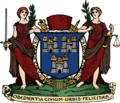The Local Government (Dublin) Act 1993 was an Act passed by the Oireachtas. It abolished the County Dublin and awarded county status to:
- Dún Laoghaire–Rathdown and established Dún Laoghaire–Rathdown County Council,
- South Dublin and established South Dublin County Council and
- Fingal and established Fingal County Council.
These new administrative counties have all the powers and institutions of the traditional counties.
Section 9 Part 1(a) states that on the establishment day (1 January 1994) the previous county of Dublin "shall cease to exist."
Section 15 Part 2 dissolved the former Dún Laoghaire Corporation.
The Bill had been proposed by the Minister for the Environment, Michael Smith.
